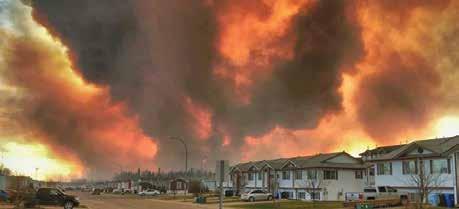
4 minute read
The calm before the storm
By Brian Shedden, BSS®, Principal, Entuitive


Imust admit that there was a time when I thought that “global warming” sounded like a pretty good thing. After all, this is Canada. As I sit in Edmonton today to write this article, with a windchill of -25° Celcius, I think that most folks could empathize with a desire for a little more warmth.
Alas, about 15 years ago, we began to morph from global warming to the more accurate definition of “climate change”, and then everything changed. The effects of the warming of the planet began to manifest itself in rising sea levels, disappearing sea ice, more severe storms, increased flooding, wildfires and general mayhem, all of which threatened the built environment which humans have continued to build from time immemorial.
As you are reading the inaugural issue of ABEC’s new magazine, let’s turn our attention to what brings us together: the building envelope.
As we have seen in Alberta over the past few years, tremendous hail storms and wildfires have had the biggest impact on our buildings and their envelopes. We have seen entire communities in Northeast Calgary have their vinyl siding shredded in violent hail storms and in Fort McMurray, the wildfires swept through entire neighbourhoods in 2017 and the rebuilding is still not complete. In both of these cases, I would argue that the lack of robust building envelope assemblies is in part responsible for the extent of the damages. The protection that a 24-inch deep soffit used to provide to our walls is gone in favour of a “sleeker” look. Vinyl siding, the use of which has really hit what I would term “peak vinyl”, has provided our walls with protection against rain, but not high winds or hail. The use of materials which provide no protection against fire have proliferated to the point where frankly, the first two of the Three Little Pigs had structures that were as robust as we construct now.
It’s April in Alberta. It’s the calm before the storm period. Over the next two to three months, our structures will be subjected to ever increasingly intense storms and what are we, as building science practitioners, going to do about it?
I have a few ideas:
1. Friends should not let friends clad their structures with vinyl siding.
When light reflected from an adjacent window can melt it, don’t use it.
2. Soffits not only provide protection to walls, but they are also great for venting the attic spaces. Where is the soffit in your design?
3. Engage your clients in undertaking preventative roof maintenance and check their roofs twice per year and let’s challenge the roofing manufacturers to provide options that are more robust than single ply membranes.
4. Think about fire. How combustible is the material you are designing with?
5. Think about impact. This could be from things as simple as landscaping maintenance or flying debris. Check out Dade County’s requirements for impact damage if you want to get ahead of the curve here. They know
a thing or two about hurricanes and high winds.
6. Think about embodied carbon. After all, that is one of the reasons we have the mess we are now facing. Which materials will lessen the impact on the environment?
7. Think about glass. If the outer lite of the glazing you are designing is not tempered or laminated, ask yourself why?
I know, the age old saying that “we don’t have the budget” is usually the reason we end up with structures that do not perform well. So, start looking at the life-cycle costs, look at the carbon costs, look at the maintenance costs and be ready to discuss all of this with your clients. After all, our role in this industry is to move it forward, employing science in service of our goals.
Use this period of time before the next big storm hits to really consider what you as a designer can do to mitigate its effects. It’s a challenge that I know we are up for and I look forward to seeing what we can collectively achieve here in Alberta.
Brian Shedden, BSS® Principal, Entuitive


Azon Saves Energy
Daylighting systems produced with Azon structural thermal barrier technologies—the MLP™ or Dual Cavity—for aluminum windows and curtain wall, along with high performanceglazing components for insulating glass, will yield a fenestration system capable of upholding the highest efficiency and sustainability standards
Contact us to learn about the role of Azon thermal barriers in energy conservation.









